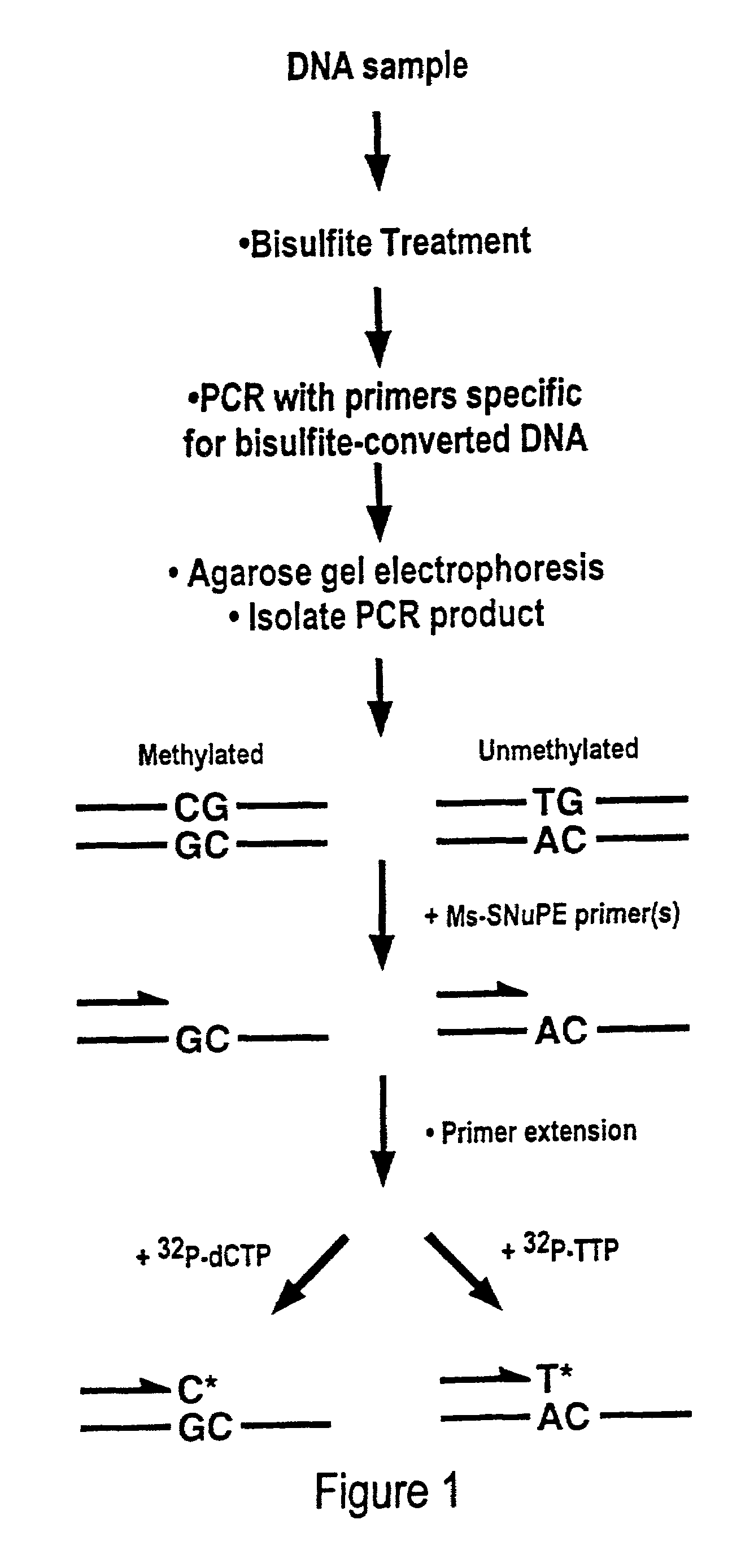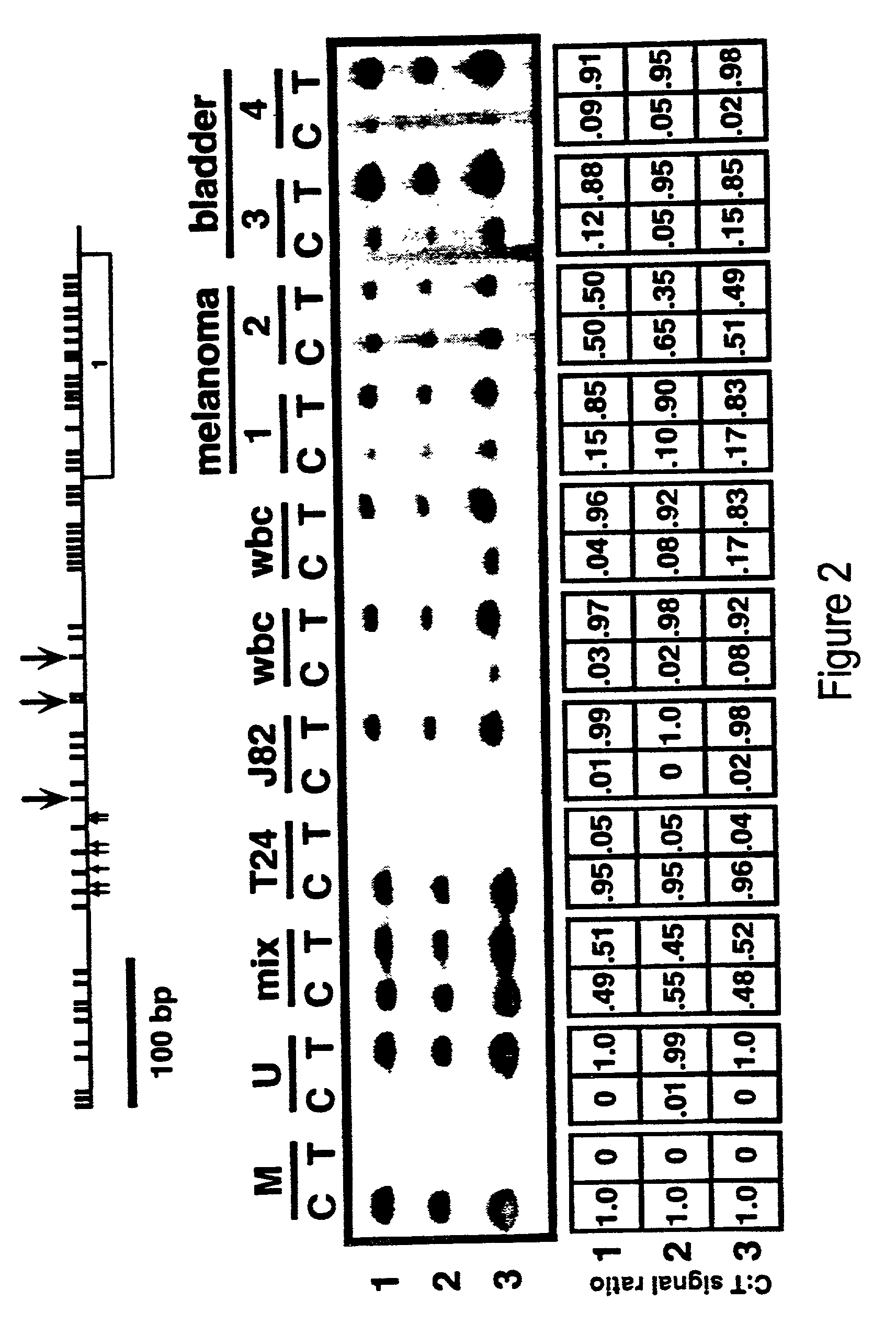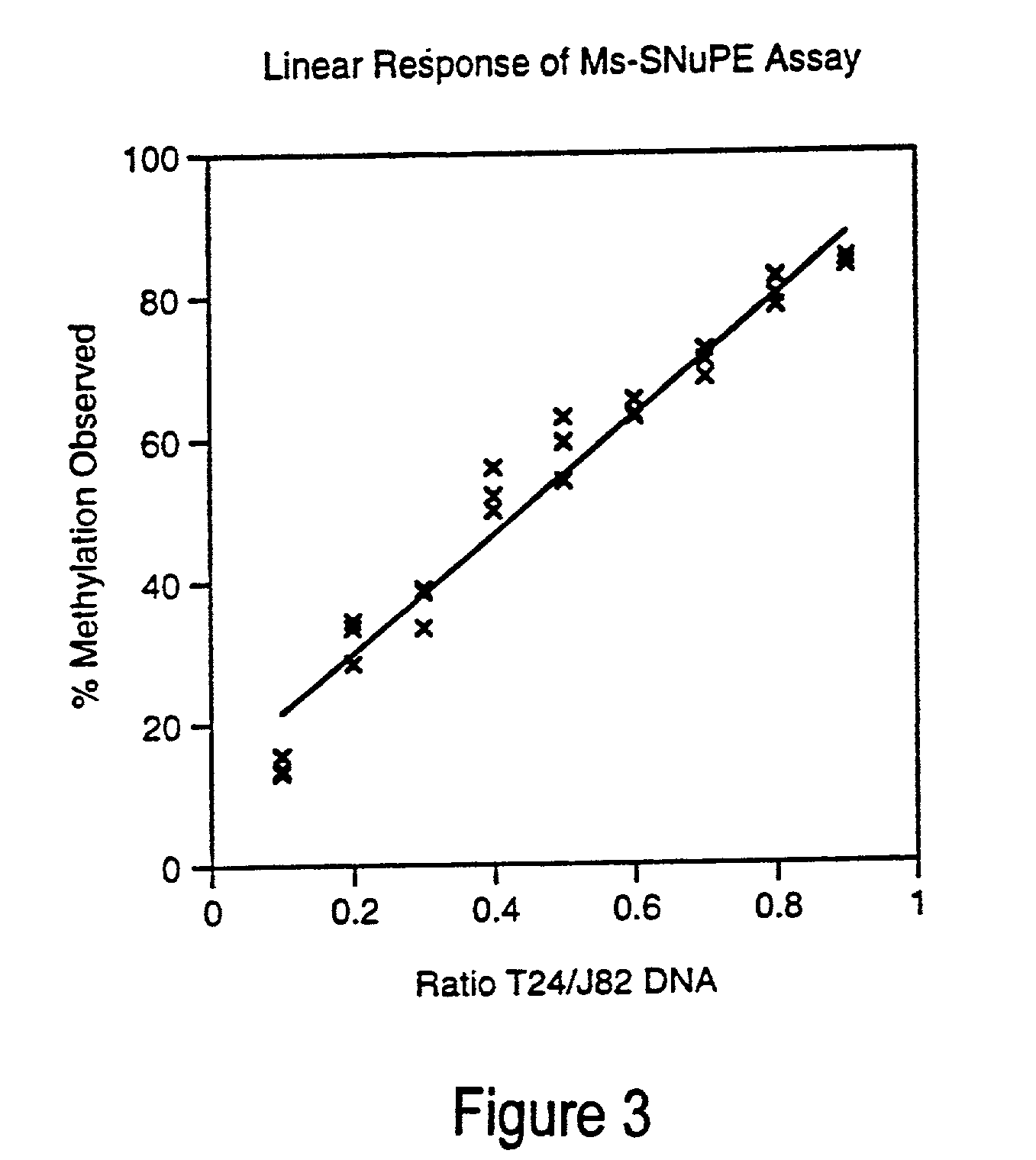Cancer diagnostic method based upon DNA methylation differences
a technology of methylation differences and cannabinoid, applied in biochemistry apparatus and processes, fermentation, organic chemistry, etc., can solve the problems of genome instability, decreased gene expression, and methylation's potential to alter gene expression
- Summary
- Abstract
- Description
- Claims
- Application Information
AI Technical Summary
Benefits of technology
Problems solved by technology
Method used
Image
Examples
example 1
[0045]This example illustrates a quantitative methylation analysis of three top strand sites in a 5′ CpG island of p16 in various DNA samples using the inventive method. The top panel provides the locations of three sites analyzed (numbered 1, 2 and 3) relative to the putative transcriptional start sites (vertical arrows pointing upwards) and the exon 1α coding domain. The PCR primers used for top strand amplification of the 5′ region of p16 (which includes putative transcriptional start sites) were 5′-GTA GGT GGG GAG GAG TTT AGT T-3′ [SEQ ID NO. 13] and 5′-TCT AAT AAC CAACCA ACC CCT CC-3′ [SEQ ID NO. 14]. The reactions were performed in 25 μl total volume under the conditions of 50 ng bisulfite-treated DNA, 10 mM Tris-HCl (pH 8.3), 1.5 mM MgCl2, 50 mM KCl, 0.1% gelatin / ml, 100 μM of each dNTP, 0.5 μM final concentration of each primer and 1U of Taq polymerase (Boehinger Mannheim, Indianapolis, Ind.). The reactions were hot-started using a 1:1 mixture of Taq / TaqStart antibody (Clont...
example 2
[0049]This example illustrates a mixing experiment showing a linear response of the inventive Ms-SNuPE assay for detection of cytosine methylation. A T24 bladder cancer cell line DNA (predominantly methylated) was added in increasing amounts to a J82 bladder cancer cell line DNA (predominantly unmethylated). FIG. 3 shows data from an 18 mer oligonucleotide [SEQ ID NO. 16] which was used in multiplex analysis of CpG methylation (site 2) of the p16 5′CpG in combination with a 15-mer and 21-mer primer [SEQ ID NOS 17 and 15, respectively] (correlation coefficient=0.99). Both the 15 mer and 21-mer produced a nearly identical linear response as the 18-mer. FIG. 3 shows data from three separate experiments. Differential specific activity and incorporation efficiency of each [32P]dNTP was controlled for by using a 50:50 mixture of bisulfite-specific methylated versus unmethylated PCR template for analysis.
example 3
[0050]This example provides a summary of DNA regions for which Ms-SNuPE primers can be designed and the inventive method applied for a quantitative detection of abnormal DNA methylation in cancer cells. The sequences are listed according to name, size and frequency of hypermethylation in the corresponding cell line or primary tumor.
[0051]
hyper-hyper-methyl-methyl-methyl-ated inated inated infrag-sizecoloncolonbladderment(bp)cell linecancercancercommentsGaL15307 / 73 / 7 (42%)3 / 7 (42%)GC content (0.6),(100%)observed / expectedCpG (0.63)GaL23087 / 74 / 5 (80%)6 / 7 (85%)GC content (0.6),(100%)observed / expectedCpG (0.6)GaL41777 / 71 / 2 (50%)3 / 4 (75%)GC content (0.59),(100%)observed / expectedCpG (0.50)CaS12154 / 7 (57%)0 / 5 (0%)2 / 7 (28%)GC content (0.55),observed / expectedCpG (0.78)CaS22204 / 7 (57%)3 / 5 (60%)3 / 7 (42%)GC content (0.54),observed / expectedCpG (0.74)CaS41966 / 7 (85%)0 / 5 (0%)1 / 7 (14%)GC content (0.64),observed / expectedCpG (0.84)HuN11487 / 73 / 5 (60%)3 / 7 (42%)GC content (0.54),(100%)observed / expectedCp...
PUM
| Property | Measurement | Unit |
|---|---|---|
| Dynamic viscosity | aaaaa | aaaaa |
| Length | aaaaa | aaaaa |
| Fluorescence | aaaaa | aaaaa |
Abstract
Description
Claims
Application Information
 Login to View More
Login to View More - R&D
- Intellectual Property
- Life Sciences
- Materials
- Tech Scout
- Unparalleled Data Quality
- Higher Quality Content
- 60% Fewer Hallucinations
Browse by: Latest US Patents, China's latest patents, Technical Efficacy Thesaurus, Application Domain, Technology Topic, Popular Technical Reports.
© 2025 PatSnap. All rights reserved.Legal|Privacy policy|Modern Slavery Act Transparency Statement|Sitemap|About US| Contact US: help@patsnap.com



